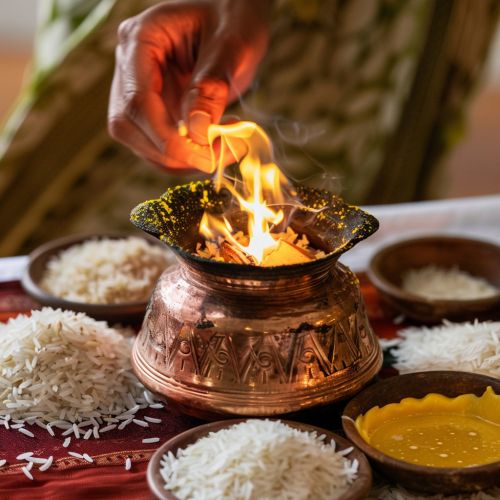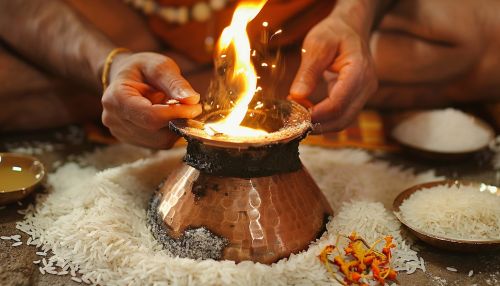Agnihotra: Difference between revisions
(Created page with "== Introduction == '''Agnihotra''' is an ancient Vedic ritual of offering two portions of milk, ghee, or other substances into a specially prepared fire at sunrise and sunset. This practice is rooted in the Atharvaveda and is considered a part of the broader Yajna rituals. Agnihotra is believed to purify the environment and the practitioner, aligning them with the natural rhythms of the universe. The ritual is performed with precise chants and specific mater...") |
No edit summary |
||
| Line 21: | Line 21: | ||
The ritual involves chanting specific [[Mantras]] from the Vedas. The most commonly used mantras are from the [[Yajurveda]]. The offerings are made by placing small portions of rice and ghee into the fire while chanting these mantras. The fire is maintained in a small, specially designed copper or clay pot. | The ritual involves chanting specific [[Mantras]] from the Vedas. The most commonly used mantras are from the [[Yajurveda]]. The offerings are made by placing small portions of rice and ghee into the fire while chanting these mantras. The fire is maintained in a small, specially designed copper or clay pot. | ||
[[Image:Detail-91863.jpg|thumb|center|A person performing Agnihotra ritual with a small fire in a copper pot, surrounded by offerings of rice and ghee.|class=only_on_mobile]] | |||
[[Image:Detail-91864.jpg|thumb|center|A person performing Agnihotra ritual with a small fire in a copper pot, surrounded by offerings of rice and ghee.|class=only_on_desktop]] | |||
== Scientific Perspective == | == Scientific Perspective == | ||
Latest revision as of 07:21, 19 June 2024
Introduction
Agnihotra is an ancient Vedic ritual of offering two portions of milk, ghee, or other substances into a specially prepared fire at sunrise and sunset. This practice is rooted in the Atharvaveda and is considered a part of the broader Yajna rituals. Agnihotra is believed to purify the environment and the practitioner, aligning them with the natural rhythms of the universe. The ritual is performed with precise chants and specific materials, making it a highly specialized practice within Hinduism.
Historical Context
Agnihotra has its origins in the early Vedic period, dating back to around 1500 BCE. It is mentioned in various Vedic texts, including the Rigveda, Yajurveda, and Atharvaveda. The practice was initially performed by Brahmins as part of their daily duties and was considered essential for maintaining the cosmic order, or Rta.
Ritual Procedure
Materials Required
The materials required for Agnihotra include a small copper or clay pot, cow dung cakes, ghee (clarified butter), rice grains, and specific wooden sticks from trees like Ficus religiosa (Peepal) or Madhuca longifolia (Mahua). The fire is ignited using cow dung cakes, and the offerings are made with ghee and rice grains.
Timing and Location
Agnihotra is performed precisely at sunrise and sunset. The practitioner must face east during the morning ritual and west during the evening ritual. The exact timing is crucial, and practitioners often use Panchang (Hindu calendar) to determine the precise moments of sunrise and sunset.
Chanting and Offerings
The ritual involves chanting specific Mantras from the Vedas. The most commonly used mantras are from the Yajurveda. The offerings are made by placing small portions of rice and ghee into the fire while chanting these mantras. The fire is maintained in a small, specially designed copper or clay pot.


Scientific Perspective
Agnihotra has been the subject of various scientific studies, particularly in the fields of environmental science and agriculture. Some studies suggest that the ritual may have a purifying effect on the environment, reducing air pollution and promoting plant growth. The combustion of cow dung and ghee is believed to release beneficial compounds such as phenols and formaldehyde, which can neutralize harmful pollutants.
Philosophical Significance
Agnihotra is not merely a ritual but a spiritual practice aimed at achieving harmony with the cosmos. It is believed to create a subtle energy field that purifies the mind and body, promoting physical and mental well-being. The practice is also associated with the concept of Karma, as it is considered a selfless act of offering to the divine.
Modern Practice
In contemporary times, Agnihotra has seen a resurgence, particularly among those interested in spirituality and environmental sustainability. Various organizations and communities around the world have adopted the practice, often integrating it with modern ecological and holistic health practices. Workshops and training sessions are frequently conducted to teach the precise methods and benefits of Agnihotra.
Criticisms and Controversies
While Agnihotra is revered by many, it has also faced criticism and skepticism, particularly from the scientific community. Critics argue that the purported environmental benefits lack rigorous scientific validation and that the practice may be more symbolic than effective. Additionally, some view it as a ritualistic practice that may not align with modern scientific principles.
